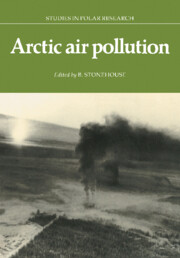Book contents
- Frontmatter
- Contents
- CONTRIBUTORS TO THIS VOLUME
- FOREWORD
- INTRODUCTION: INTERNATIONAL SYMPOSIUM ON ARCTIC AIR POLLUTION
- Part 1 Composition, source areas and transport pathways
- Part 2 Local, regional, global, ecological and climatic implications
- Part 3 Health and ecological issues
- Part 4 International cooperation and state responsibility
- The impact of human and industrial activities on the Arctic environment: legal considerations and international liabilities
- Cooperation of China, Japan and United States in the study of long-range aerosol transport to the Pacific and Arctic
- International scientific cooperation in the Arctic: problems, opportunities and US responsibilities
- Arctic haze and bush Alaskan villages
- Arctic air pollution and Alaska's concerns
- Modern life systems of indigenous people of bush Alaska
- 5 Conclusions
- Index
Cooperation of China, Japan and United States in the study of long-range aerosol transport to the Pacific and Arctic
Published online by Cambridge University Press: 03 May 2010
- Frontmatter
- Contents
- CONTRIBUTORS TO THIS VOLUME
- FOREWORD
- INTRODUCTION: INTERNATIONAL SYMPOSIUM ON ARCTIC AIR POLLUTION
- Part 1 Composition, source areas and transport pathways
- Part 2 Local, regional, global, ecological and climatic implications
- Part 3 Health and ecological issues
- Part 4 International cooperation and state responsibility
- The impact of human and industrial activities on the Arctic environment: legal considerations and international liabilities
- Cooperation of China, Japan and United States in the study of long-range aerosol transport to the Pacific and Arctic
- International scientific cooperation in the Arctic: problems, opportunities and US responsibilities
- Arctic haze and bush Alaskan villages
- Arctic air pollution and Alaska's concerns
- Modern life systems of indigenous people of bush Alaska
- 5 Conclusions
- Index
Summary
ABSTRACT. Three laboratories in China, Japan, and the United States have initiated cooperative investigations of atmospheric aerosol formation and transport to the Pacific and Arctic. Both desert dust and air pollutants from urban or industrial areas have been sampled near their sources in China, at sites in Japan, above the marine boundary layer on Hawaii, and over the Arctic Ocean. Aerosols, sorted by particle size or temporally resolved using cascade impactors or time sequence filter samplers, were analyzed for elemental composition by proton-induced X-ray emission (PIXE). Dust storms in China greatly raised concentrations of very coarse particles, but particles finer than 1 fim (those of greatest human health concern) are raised much less. Dust carried over Japan during spring contains three components—soil particles, sea salts and air pollution sulfur—recognizable by element concentrations in filter samples collected sequentially. Hawaiian springtime aerosol contains particulate sulfur temporally coherent with soil dust, suggesting trans-Pacific Asian pollution and desert sources. Arctic aerosol, sampled in spring by aircraft-mounted cascade impactor, contains both fine pollution sulfur and soil elements mainly in ultra-coarse particles more than 16 μm in diameter, with Si/Al approximating that of shales or clay minerals but less than in average earth crust or Asian loess. Dust from a Chinese desert area shows Si/Al close to average earth crust or loess.
- Type
- Chapter
- Information
- Arctic Air Pollution , pp. 281 - 288Publisher: Cambridge University PressPrint publication year: 1987
- 1
- Cited by



